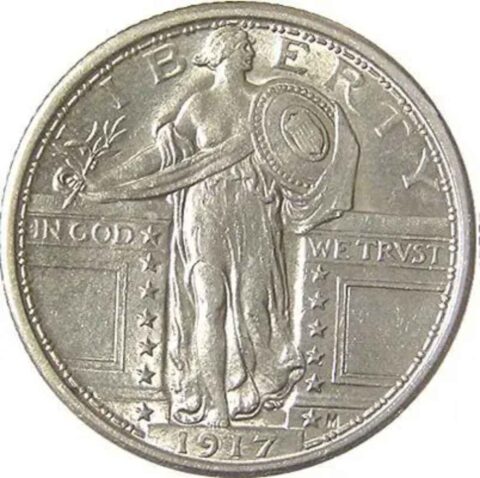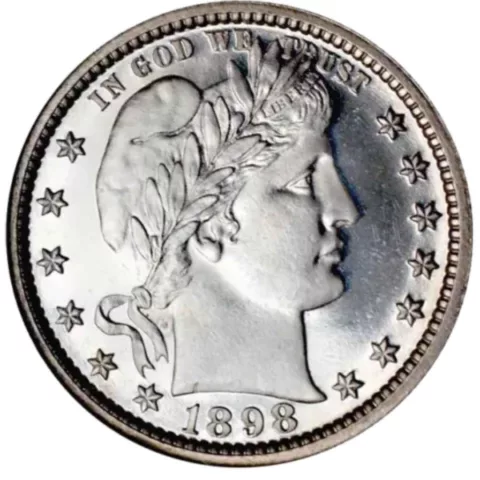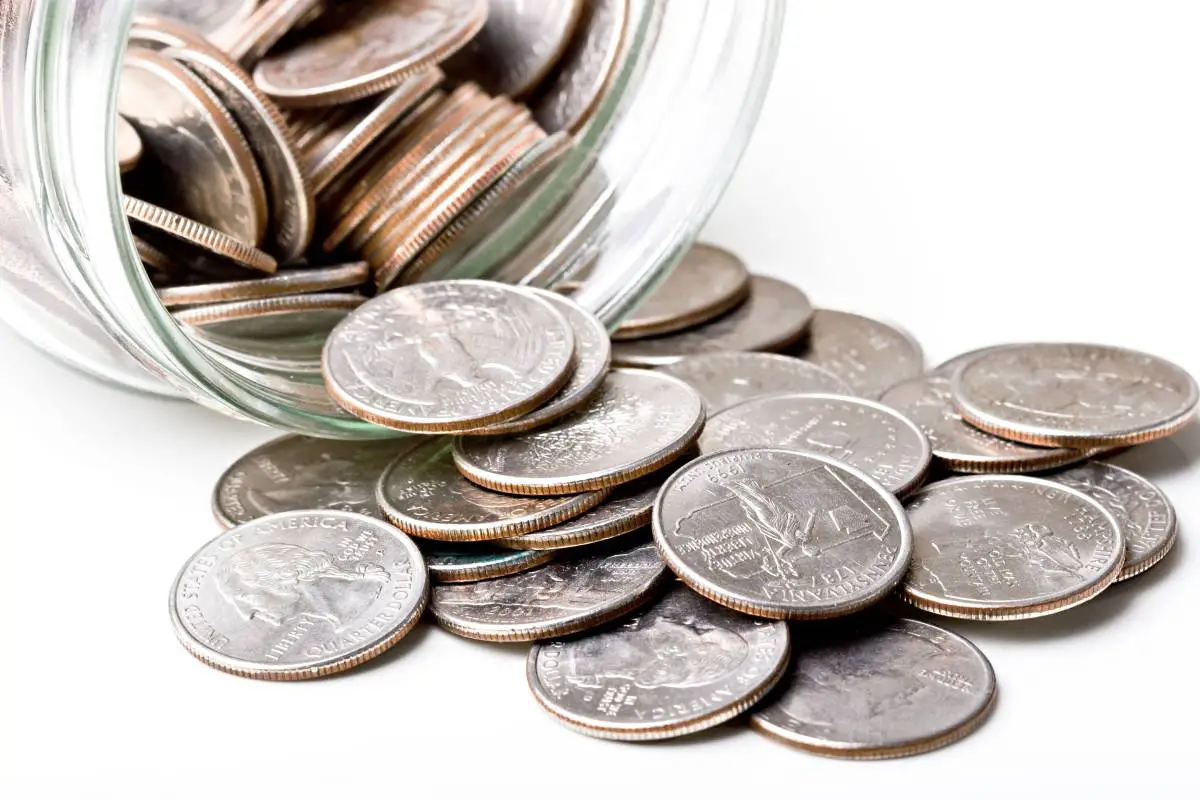How To Grade U.S. Quarters
In a previous article I listed information that will help you get an approximate idea of the grade of your coin.
Now I’m going to go into detail describing how to obtain exact grades for your circulated quarters.
The grade (condition) of a coin is one of the most important factors in determining that coin’s value.

There are 3 types of U.S. quarters that I will cover here:
- Washington quarter (1932–present)
- Standing Liberty quarter (1916–1930)
- Barber quarter (1892–1916)
How to identify the various parts of a coin + What the coin grade abbreviations and numbers mean.
Let’s start with the common Washington quarter…
Washington Quarter Grades

AU-55
- Obverse: Only a trace of wear shows on the highest points of hair in front and in back of ear.
- Reverse: A trace of wear shows on the highest spots of breast feathers. Nearly all mint luster still present.
AU-50
- Obverse: Traces of wear show on hair in front and in back of ear.
- Reverse: Traces of wear show on legs and breast feathers. 3/4 of mint luster still present.
EF-45
- Obverse: Slight wear shows on high points of hair around ear and along hair line up to crown. Hair lines are sharp and detailed.
- Reverse: High points of legs are lightly worn. Breast feathers are worn but clearly defined and fully separated. Half of mint luster still present.
EF-40
- Obverse: Wear shows on high points of hair around and at hairline up to crown.
- Reverse: High points of breast, legs, and claws are lightly worn but all details are clearly defined and partially separated. Part of mint luster still present.
VF-30
- Obverse: Wear spots show on hair at forehead, ear, cheek, and jaw. Hairlines are weak but have nearly full visible details.
- Reverse: Wear shows on breast but a few feathers are visible. Legs are worn smooth. Most details in wings are clear.
F-12
- Obverse: Details show only at back of hair. Motto is weak but clearly visible. Part of cheek edge is worn away.
- Reverse: Feathers in chest and legs are worn smooth. Leaves show some detail. Parts of wings are nearly smooth.
VG-8
- Obverse: Entire head is weak and most details in hair are worn smooth. All letters and date are clear. Rim is complete.
- Reverse: About half of wing feathers are visible. Breast and legs only outlined. Leaves show very little detail. Rim is complete.
G-4
- Obverse: Hair is well worn with very little detail remaining. Half of motto is readable. LIBERTY and date are weak but visible. Rim merges with letters.
- Reverse: Eagle is worn nearly flat but is completely outlined. Leaves, breast, and legs are worn smooth. Legend is all visible but merges with rim.
AG-3
- Obverse: Head is outlined with nearly all details worn away. Date readable but worn. Traces of motto are visible. Legend merging into rim.
- Reverse: Entire design partially worn away. Rim merges into legend.
Standing Liberty Quarter Grades

AU-55
- Obverse: Only a trace of wear shows on highest points of mail covering breast, inner shield, and right knee.
- Reverse: A trace of wear shows on breast and edges of wings. 3/4 of mint luster still present.
AU-50
- Obverse: Traces of wear show on breast,knee, and high points of inner shield.
- Reverse: Traces of wear show on edges of wings and at center of breast. All tail feathers visible. Half of mint luster present.
EF-45
- Obverse: Light wear spots show on upper right leg and knee. Nearly all gown lines are clearly visible. Shield details are bold. Breast is lightly worn and may show small flat spot.
- Reverse: Small flat spots show on high points of breast and on front wing edges. Tail feathers have nearly full details. Part of mint luster still present.
EF-40
- Obverse: Wear shows on breast and right leg above and below knee. Most of gown lines visible. Shield details bold. Breast is well rounded but has small flat spot.
- Reverse: High points of eagle are lightly worn. Central part of edge on right wing is well worn. Traces of mint luster may still show.
VF-30
- Obverse: Wear spots show on breast,shield, and leg. Right leg is rounded but worn from above knee to ankle. Gown line crossing thigh is partially visible. Half of mail covering breast can be seen. Circle around inner shield is complete.
- Reverse: Breast and leg are worn but clearly separated with some feathers visible between them. Feather ends and folds are visible in right wing.
VF-20
- Obverse: Right leg is worn flat in central parts. Wear spots show on head, breast, shield, and foot. Beads on outer shield are visible but those next to the body are weak. Inner circle of shield is complete.
- Reverse: Entire eagle is lightly worn but most major details are visible. Breast and edge of right wing are worn flat. Top tail feathers are complete.
F-12
- Obverse: Gown details worn but show clearly across body. Left leg is lightly worn. Right leg nearly flat and toe is worn. Breast worn but some mail is visible. Date may show some weakness at top. Rim is full. Outer edge of shield is complete.
- Reverse: Breast is worn almost smooth. Half of the wing feathers are visible although well worn in spots. Rim is full.
VG-8
- Obverse: Entire design is weak and most details in gown are worn smooth. All letters and date are clear but tops of numerals may be flat. Rim is complete. Drape across breast is partially outlined.
- Reverse: About 1/3 of feathers are visible and large feathers at ends of wings are well separated. Eye is visible. Rim is full and all letters are clear.
G-4
- Obverse: Entire design well worn with very little detail remaining. Legend and date are weak but visible. Top of date may be worn flat. Rim is complete.
- Reverse: Eagle worn nearly flat but is completely outlined. Lettering and stars worn but clearly visible. Rim worn to tops of legend.
AG-3
- Obverse: Figure is outlined with nearly all details worn away. Legend visible but half worn away and may merge with rim. Date weak and readable.
- Reverse: Entire design partially worn away. Some letters merging into rim.
Barber Quarter Grades

AU-55
- Obverse: Only a trace of wear shows on highest points of hair below BER in LIBERTY.
- Reverse: A trace of wear shows on head,tip of tail, and tips of wings. 3/4 of mint luster still present.
AU-50
- Obverse: Traces of wear show on cheek, tips of leaves, and hair below LIBERTY.
- Reverse: Traces of wear show on head, neck, tail,and tips of wings. Half of mint luster still present.
EF-45
- Obverse: Slight wear shows on high points of upper leaves, cheek, and hair above forehead. LIBERTY is sharp and band edges are bold.
- Reverse: High points of head, neck, wings, and talons are lightly worn. Lines in center tail feathers are clearly defined. Part of mint luster still present.
EF-40
- Obverse: Light wear shows on leaves,cheek,cap, and hair above forehead. LIBERTY is sharp and band edges are clear.
- Reverse: High points of head, neck, wings, and tail are lightly worn but all details are clearly defined. Leaves show trace of wear on edges. Traces of mint luster may still show.
VF-30
- Obverse: Wear spots show on leaves, cap, hair, and cheek. Bottom row of leaves is weak but has some visible details. LIBERTY and band are complete. Folds in cap are distinct.
- Reverse: Wear shows on shield but all details are visible. Most details in neck and tail are clear. Motto is complete.
VF-20
- Obverse: Over half the detail still shows in leaves. Hair and ribbon worn but bold. Every letter in LIBERTY is visible.
- Reverse: The shield is worn but most details are visible. Half of details in feathers are clear. Wings and legs show wear spots. Motto is clear.
F-12
- Obverse: Some details show in hair, cap, and facial features. All letters in LIBERTY are weak but visible. Upper row of leaves is outlined but bottom row is worn nearly smooth. Rim is full and bold.
- Reverse: Half of feathers are plainly visible. Wear spots show in center of neck, motto, and arrows. Horizontal shield lines are merged and vertical lines are separated. Letters in legend are worn but clear.
VG-8
- Obverse: Entire head is weak and most details in face worn smooth. Three letters in LIBERTY are clear. Rim is complete.
- Reverse: Eagle shows only a small amount of detail. Arrows and leaves are flat. Most of the shield is very weak. Part of the eye is visible.
G-4
- Obverse: Entire design well worn with very little detail remaining. Legend is weak but visible. LIBERTY is worn away.
- Reverse: Eagle worn flat but is completely outlined. Ribbon worn nearly smooth. Legend weak but visible. Rim worn to tops of letters.
AG-3
- Obverse: Head is outlined with nearly all details worn away. Date readable but partially worn away. Legend merging into rim.
- Reverse: Entire design partially worn away and legend merges with rim.
The Bottom Line…

It takes a lot of time and experience to consistently grade coins accurately, but you’ll never get there if you don’t start somewhere.
Hopefully you’re able to grade your Washington quarters, Standing Liberty quarters, and Barber quarters better now.
Grab a coin magnifier and a copy of the U.S. Coin Grading Standards book. Then, watch this video to see how to grade coins yourself at home:



